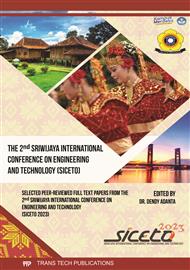p.3
p.13
p.25
p.39
p.49
p.59
p.67
Environment Effects of Refined Palm Oil (RPO) on Concrete Mixes
Abstract:
Nowadays the construction of palm oil industry mills is advancing rapidly and the next one is Refined Palm Oil (RPO). Refined Palm Oil (RPO) is one of the derivatives of palm oil processing. One option to use structures in the construction of palm oil mills is to use concrete. Plant parts that have concrete components often suffer damage, cracks and reduced concrete strength.This study is intended to examine the mechanical properties of concrete including compressive strength, flexural strength and porosity in concrete in the RPO environment, examining changes in the weight of coarse and fine aggregates immersed in RPO. This study used concrete experiments in RPO baths with 3 combinations, 54 samples and 2 types of concrete plan life, then analyzed in the laboratory. The parameters measured are changes in aggregate weight, porosity, bending strength and compressive strength of concrete. The results showed that the higher the percentage of RPO immersed in concrete, the lower the compressive strength, bending strength and porosity of the concrete. Fine aggregate undergoes weight change when immersed in RPO for 28 and 56 days, while coarse aggregate undergoes no weight change
Info:
Periodical:
Pages:
49-56
Citation:
Online since:
February 2025
Authors:
Keywords:
Price:
Сopyright:
© 2025 Trans Tech Publications Ltd. All Rights Reserved
Share:
Citation:


